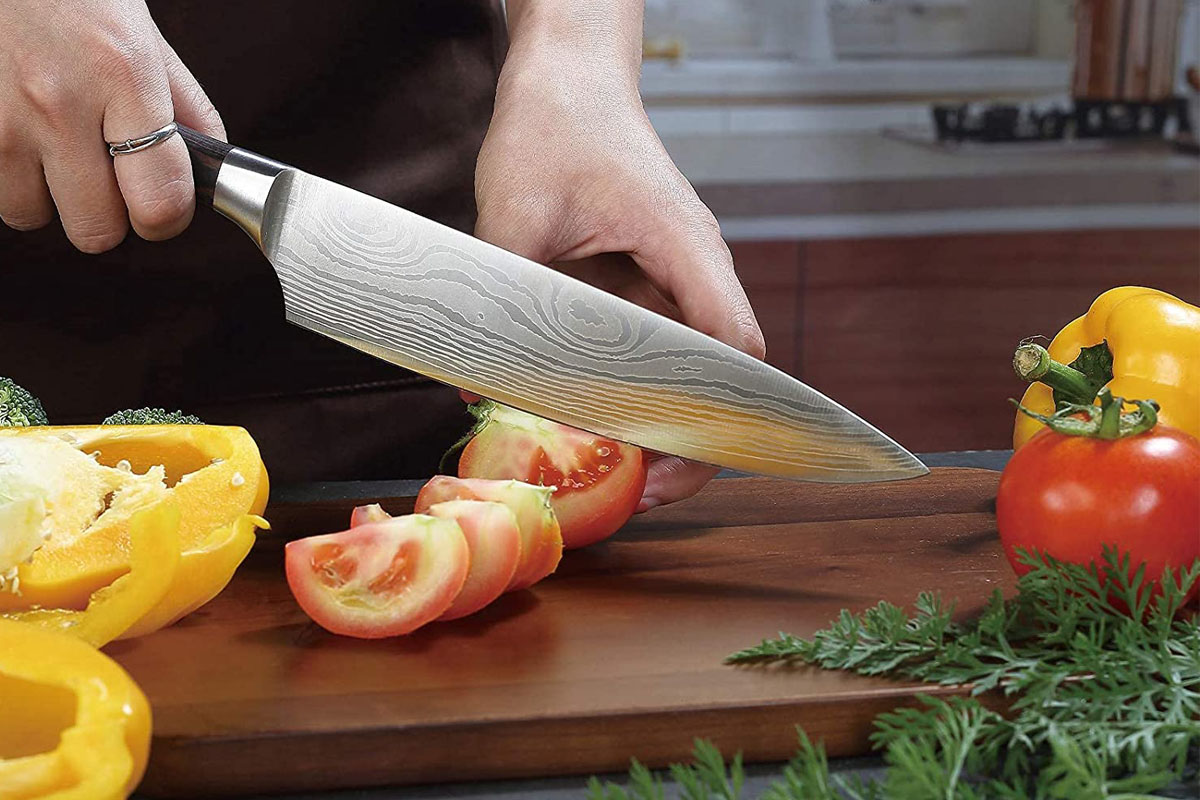We may earn revenue from the products available on this page and participate in affiliate programs. Learn More ›
If you have ever cut something with a dull knife, you are likely to value the experience of cutting with a high-quality, sharp knife. Many knives can help you perform the most rudimentary cutting tasks, but few get the job done quickly and easily. An exceptionally sharp knife is safer than a moderately sharp one, as it gives the user more control over what they are cutting. Sharpness can even affect the outcome of your food once it’s cut, making fruits and vegetables a little slower to discolor. However, it is important to remember that even the best of knives may get dull over time and will require sharpening to restore efficacy.
When it comes to preparing meals, being able to quickly chop food can undoubtedly speed up the process of getting the food cooked and in front of your family or guests as soon as possible. Whether you are a home cook or a renowned chef, it is a good idea to have the best, sharpest knives on the market at your disposal. Here are the best kitchen knife brands.
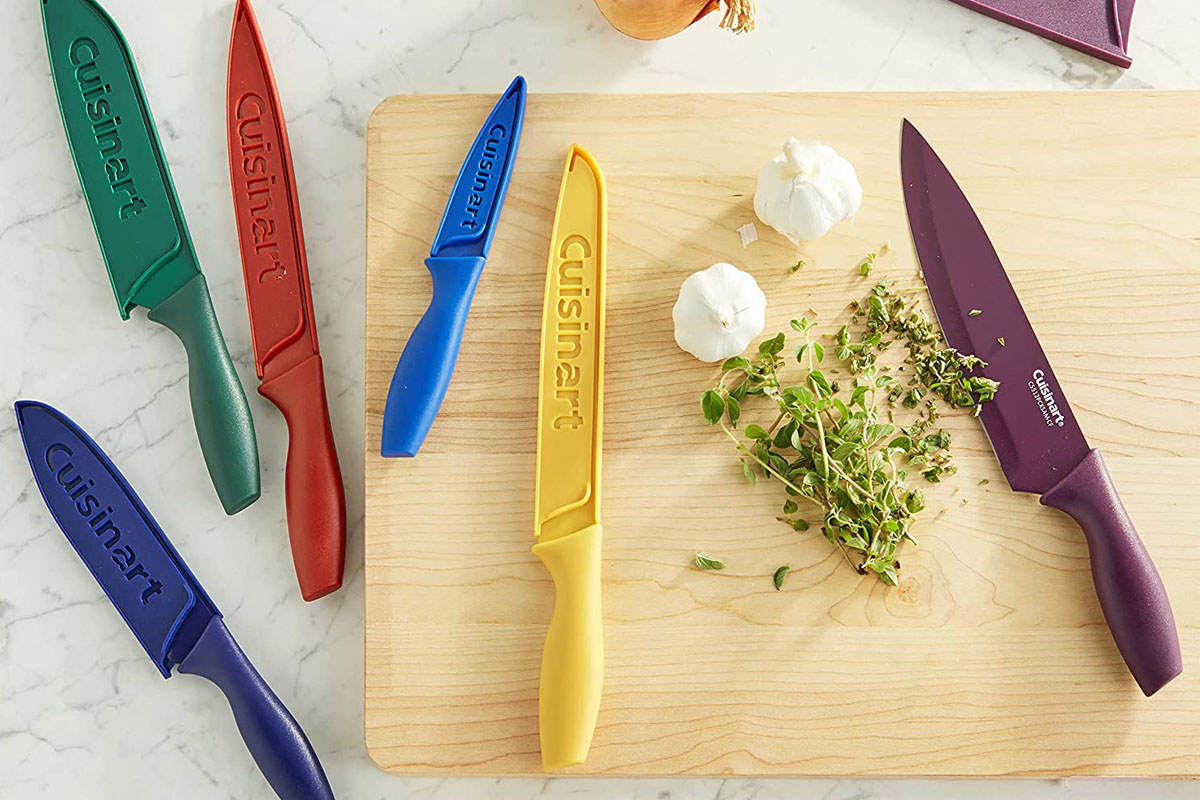
1. Cuisinart
About the Brand: This brand makes the world’s best-known food processor and many of the world’s most renowned kitchen products.
Price Range: $ to $$$
When it comes to the kitchen, Cuisinart is a brand that specializes in seemingly all facets of cooking. Their mission is to “Savor the Good Life.” They aim to do this with their home appliances, cookware, bakeware, cutlery, grill sets, gadgets, and other innovative products they introduce. Founded in 1971 by Carl Sontheimer, Cuisinart introduced the world to the food processor, which quickly slices, chops, shreds, grinds, or purees food, making vegetable preparation (and even making dough) a cinch. The company is headquartered in Stamford, Connecticut, and its management was taken over by Conair in 1989, and they’ve operated it since that time.
Celebrity chefs Julia Child and James Beard introduced the world to the Cuisinart food processor. From there, its brand has become synonymous with preparing great food, fulfilling the dream of its founder, who designed the product to help cooks make food into a “cuisine” and an “art”; thus the creation of a portmanteau of the name “Cuisinart.” Since its humble beginnings of a few kitchen products, Cuisinart has evolved into a worldwide brand that prides itself on product development and innovation. Its commitment to producing top-of-the-line culinary products has earned the favor of chefs and consumers alike. The company has also earned many awards, including the Good Design Award, the Gold Hermes Award, and the Gold Summit International Award.
One of the best things about kitchen knives made by Cuisinart is that this brand can provide a high-quality product at an affordable price point. This accessibility makes this brand’s products a staple in kitchens and restaurants worldwide.
Top Products:
- Cuisinart Advantage Color Collection 12-Piece Knife Set with Blade Guards: This 12-piece knife set includes a variety of high-quality stainless steel kitchen knives with ceramic coating in various colors—plus each knife includes a matching blade guard. Get the Cuisinart Advantage Color Collection 12-Piece Knife Set with Blade Guards on Amazon for $29.99
- Cuisinart Classic Forged 15 Piece Set: Cuisinart’s basic set of kitchen knives comes in an unusual knife-handle color of white. This 15-piece set includes a chef knife, santoku knife, steak knives, sharpening steel, and shears in a wooden knife block. Get the Cuisinart Classic Forged 15 Piece Set on Amazon for $84.99
- Cuisinart Electric Knife: Easily carve a turkey or slice bread with this electric knife that has a 10.5-inch steel blade and a 5-foot power cord. Get the Cuisinart Electric Knife at Macy’s for $37.99
Shop for more Cuisinart kitchen knives at:
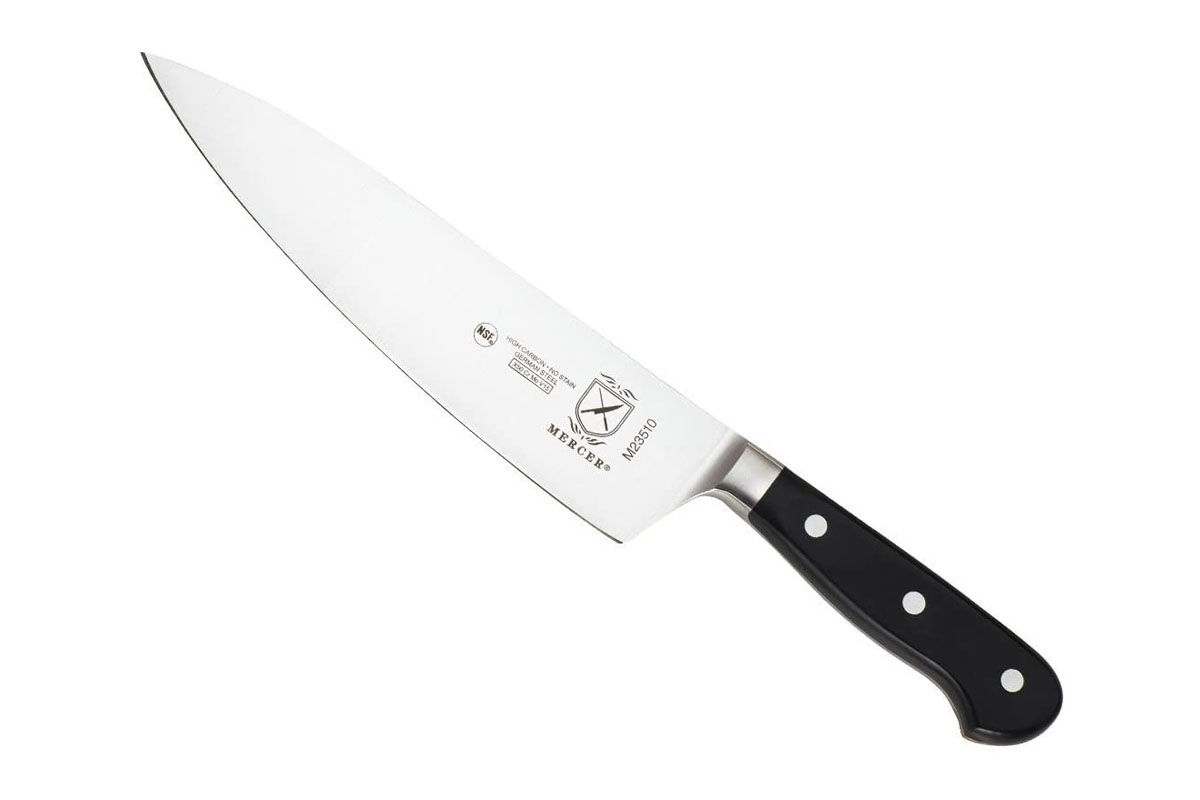
2. Mercer Culinary
About the Brand: Delivering high-quality cutlery and kitchen tools to the food services industry for more than 30 years, Mercer Culinary supplies more than 90 percent of North American culinary academies.
Price Range: $ to $$$
Mercer Culinary has been passionate about providing top-quality kitchen tools and cutlery to the food service industry since 1968. The company prides itself on creating innovative solutions to make life in the kitchen easier for culinary professionals. Mercer’s lineup of products includes top-notch turners, pie servers, peelers, pizza cutters, cutlery, plates, protective wear, and more. The company’s expert craftsmanship doesn’t just lend itself to the kitchen. Headquartered in Ronkonkoma, New York, Mercer also produces a wide range of barware products essential for bartenders to mix drinks. These products include shakers, strainers, stirring tools, measuring tools, and the like.
Mercer’s knife collection is extensive, having many categories to choose from, including MX3, Genesis, Zum, Renaissance, Millenia, and more. Its culinary products supply over 90 percent of culinary academies in North America. It also works closely with experts in the culinary field to produce products that cater to their needs. This means customers can rest assured that their knives are professional grade.
Top Products:
- Mercer Culinary Renaissance 8-Inch Chef’s Knife: An ergonomically designed German knife with long-lasting sharpness, this knife resists rust and corrosion while providing an easy and consistent cutting experience during each use. Get the Mercer Culinary Renaissance 8-Inch Chef’s Knife on Amazon for $52.58
- Mercer Culinary Millennia 8-Inch Chef’s Knife: This knife is similar to the Renaissance but at a lower price for beginners, and it might not have the same longevity. Still, it has textured finger points for slip resistance, a durable handle, and high-quality Japanese steel that maintains sharpness. Get the Mercer Culinary Millennia 8-Inch Chef’s Knife on Amazon for $26
Shop for more Mercer Culinary kitchen knives at:
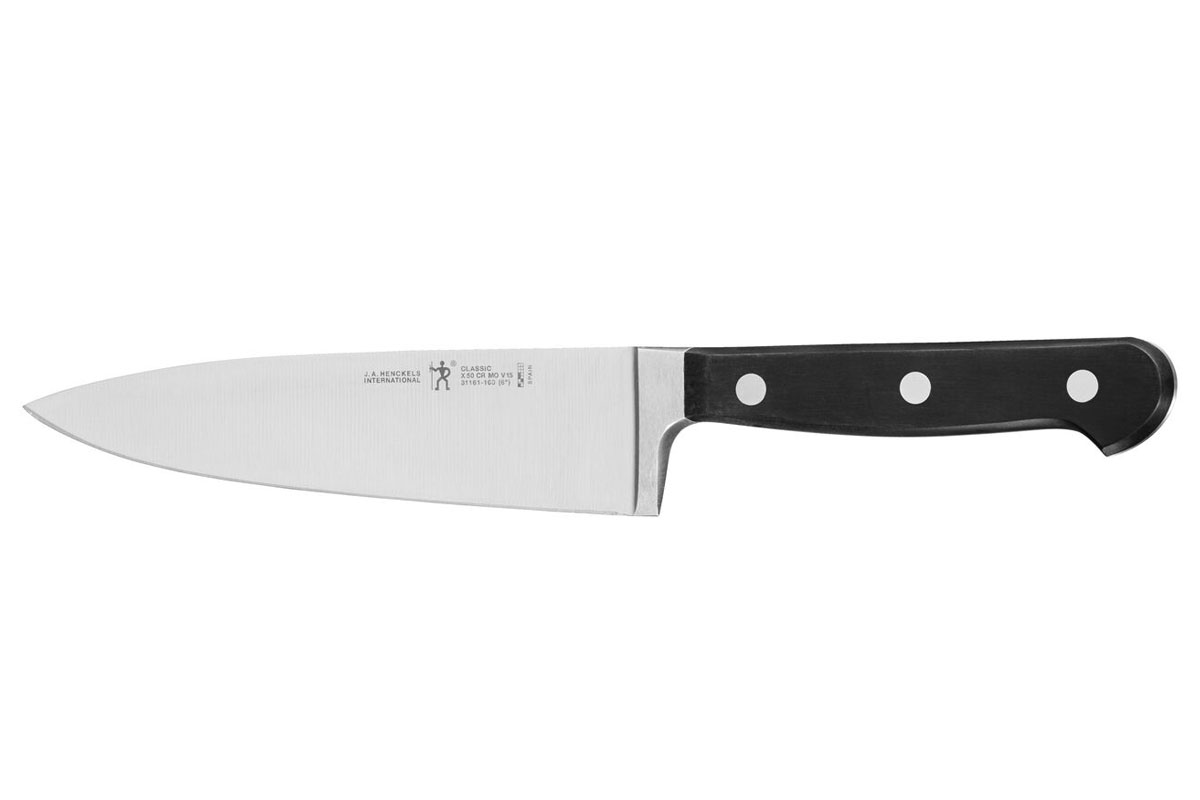
3. Zwilling J.A. Henckels
About the Brand: Beginning in 1731, J.A. Henckels is one of the oldest knife companies in the world.
Price Range: $ to $$$
Zwilling J.A. Henckels aims to set the standard for high-quality knives. The company provides various knives, including chef’s knives, paring knives, steak knives, Japanese knives, cleavers, and more. One of the best chef knife makers in history, Zwilling J.A. Henckels was founded by Peter Henckels in 1731.
Headquartered in Solingen, Germany, this kitchenware manufacturer has provided quality, innovative products for the kitchen and the hairdressing industry (not as strange a combination as it may seem, as scissors are similar in design to knives). The company provides top-quality shaving products and shears in addition to numerous kitchen products. Although most products are manufactured in Germany, manufacturing plants are also located in France, Italy, Japan, and Belgium. Each manufacturing location churns out the same quality products with the same quality and precision that Zwilling J.A. Henckels has come to be known for over the past few centuries.
Top Products:
- Henckels Zwilling Classic 8-Inch Professional Chef Knife: The Henckels Zwilling Professional Chef Knife is a Spanish-made knife made with high-grade German stainless steel that offers precision and comfortable handling with long-lasting sharpness. It’s effective at dicing apples and slicing meat. Get the Henckels Zwilling Classic 8-Inch Professional Chef Knife on Amazon for $66.39
- J.A. Henckels Zwilling Steak Knife Set: With a wood presentation case, this 8-piece high-carbon stainless steel steak knife set is a stunning addition to a table setting. Each 4-inch serrated knife is dishwasher safe, but hand-washing is recommended. Get the J.A. Henckels Zwilling Steak Knife Set at Macy’s for $142
- J.A. Henckels International Graphite Self-Sharpening Cutlery Set: This 20-piece graphite cutlery set comes with a knife block that has self-sharpening slots with ceramic honing wheels. Knives are sharpened when they are stored or removed from the ash wood block. Get the J.A. Henckels International Graphite Self-Sharpening Cutlery Set at Macy’s for $467
Shop for more Zwilling J.A. Henckels kitchen knives at:
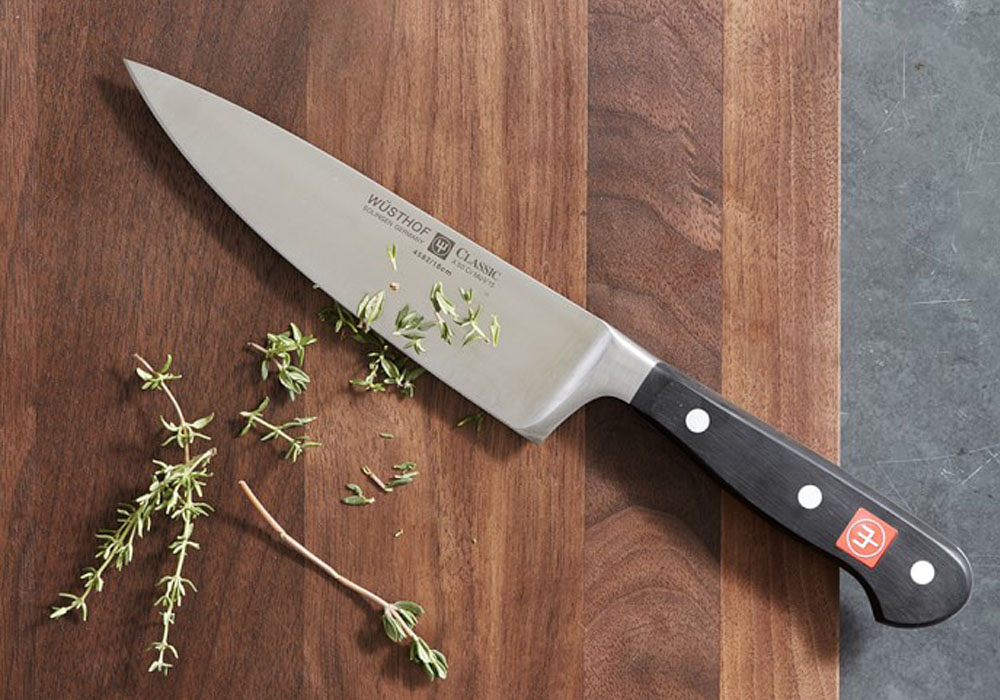
4. WÜSTHOF
About the Brand: For more than 200 years, this family-owned company has expertly crafted quality knives in Solingen, Germany.
Price Range: $$ to $$$$
Wüsthof is another German knife company that is headquartered in Solingen, Germany. It was founded in 1814 by Johann Abraham Wüsthof, and through many struggles, including two major world wars that threatened to wipe it out, it has remained in business. Not only has it remained in business, but it has also remained a family-owned business that is still run by the Wüsthof family today in its seventh generation. It began as a shears company, but once Johann Wüsthof’s son, Eduard, took over the company, he began to sell various types of knives. Now it’s become one of the world’s most progressive manufacturers run by cousins Viola Wüsthof and Harald Wüsthof.
This company has remained resilient and innovative despite many outside factors that threatened to tear it apart over the years. And this same versatility can be seen in its high-quality products. Its lineup of products caters to food professionals and cooking enthusiasts the world over. The company makes paring knives, chef’s knives, bread knives, Asian knives, and many other knives, storage products, and accessories.
Top Products:
- WÜSTHOF Classic Chef’s Knife: The Precision Edge Technology (PEtec) provides superior edge retention, keeping this 8-inch knife sharp as an all-purpose wonder in the kitchen that’s perfect for slicing, chopping, mincing, and dicing. Get the WÜSTHOF Classic Chef’s Knife at Williams Sonoma for $170
- WÜSTHOF Gourmet In-Drawer Knife Set: A seven-piece set with full tang, these knives fit in a rubberwood knife tray that fits inside most kitchen drawers. Get the WÜSTHOF Gourmet In-Drawer Knife Set at Crate & Barrel for $360
- WÜSTHOF Classic Paring Knife: For more detailed and delicate work, the demi-bolster paring knife with full tang maintains sharpness and has a tempered and hardened steel blade. Get the WÜSTHOF Classic Paring Knife on Amazon for $85
Shop for more WÜSTHOF kitchen knives at:
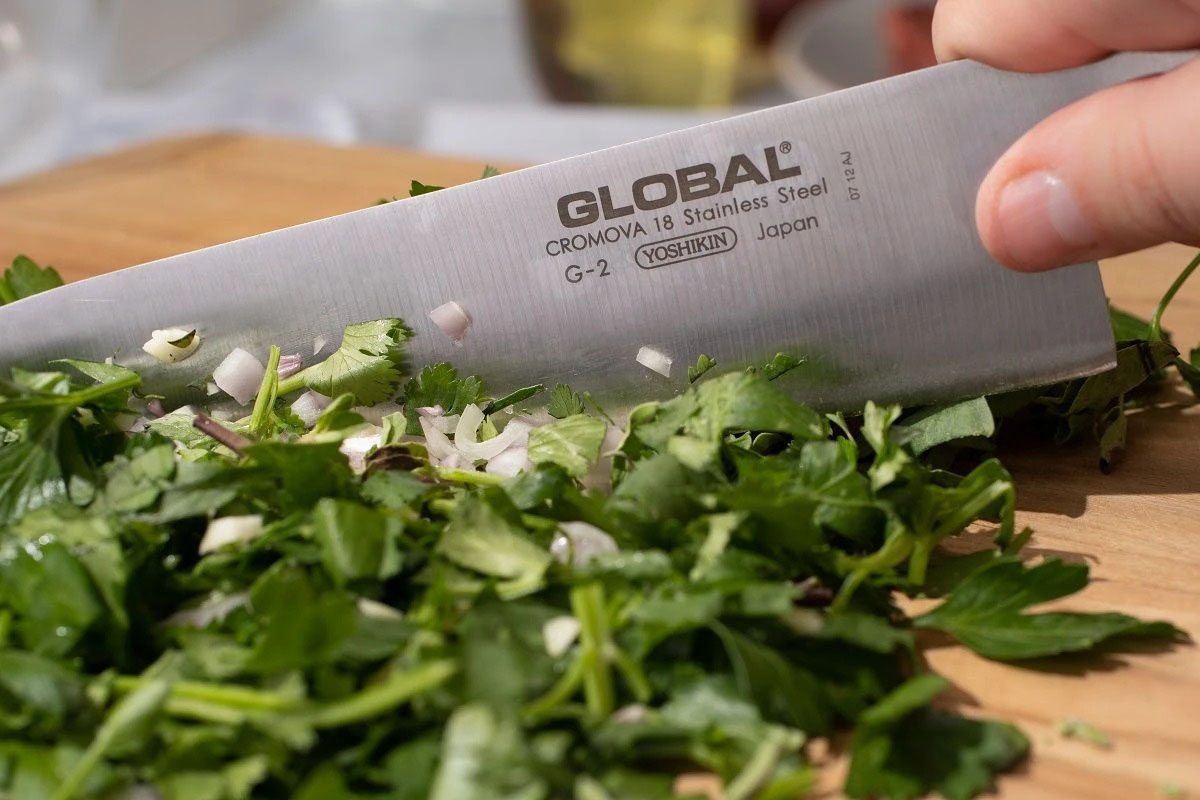
5. Global Cutlery USA
About the Brand: This hand-crafted Japanese knife company is steeped in Samurai sword-making tradition.
Price Range: $$ to $$$
Global Cutlery’s knives are Japanese knives that are suited for numerous kitchen tasks. The company was established in 1985, creating knives for cooking by using the old Samurai sword-making techniques. Each knife is handcrafted in Japan. A superior blend of molybdenum and vanadium is used to forge these durable knives.
Used by professional chefs and home chefs alike, Global Cutlery’s aerodynamic knife designs are razor-sharp, which reduces hand fatigue for users. As a result, you can spend a tremendous amount of time cutting before getting tired. Plus there’s no worry about a dull blade. Global Cutlery’s knives retain their sharp edge longer than many knives on the market due to their ingenious design: A straight edge is used instead of the standard beveled edge. However, keep in mind that even the best knives may dull over time and will require sharpening to restore cutting capacity.
Top Products:
- Global Classic 8″ Chef’s Knife: A lightweight vanadium stainless steel chef’s knife, this is comfortable to grip and perfectly balanced. Get the Global Classic 8″ Chef’s Knife at Global Cutlery USA for $124.95
- Global Model X Chef’s Knife: This stamped chef’s knife is less durable than a professional’s full-tang knife, but it does offer long-enduring sharpness, a unique lightweight stainless steel mix, and handle dimpling for a better grip. Get the Global Model X Chef’s Knife on Amazon for $159.95
Shop for more Global Cutlery USA kitchen knives at:
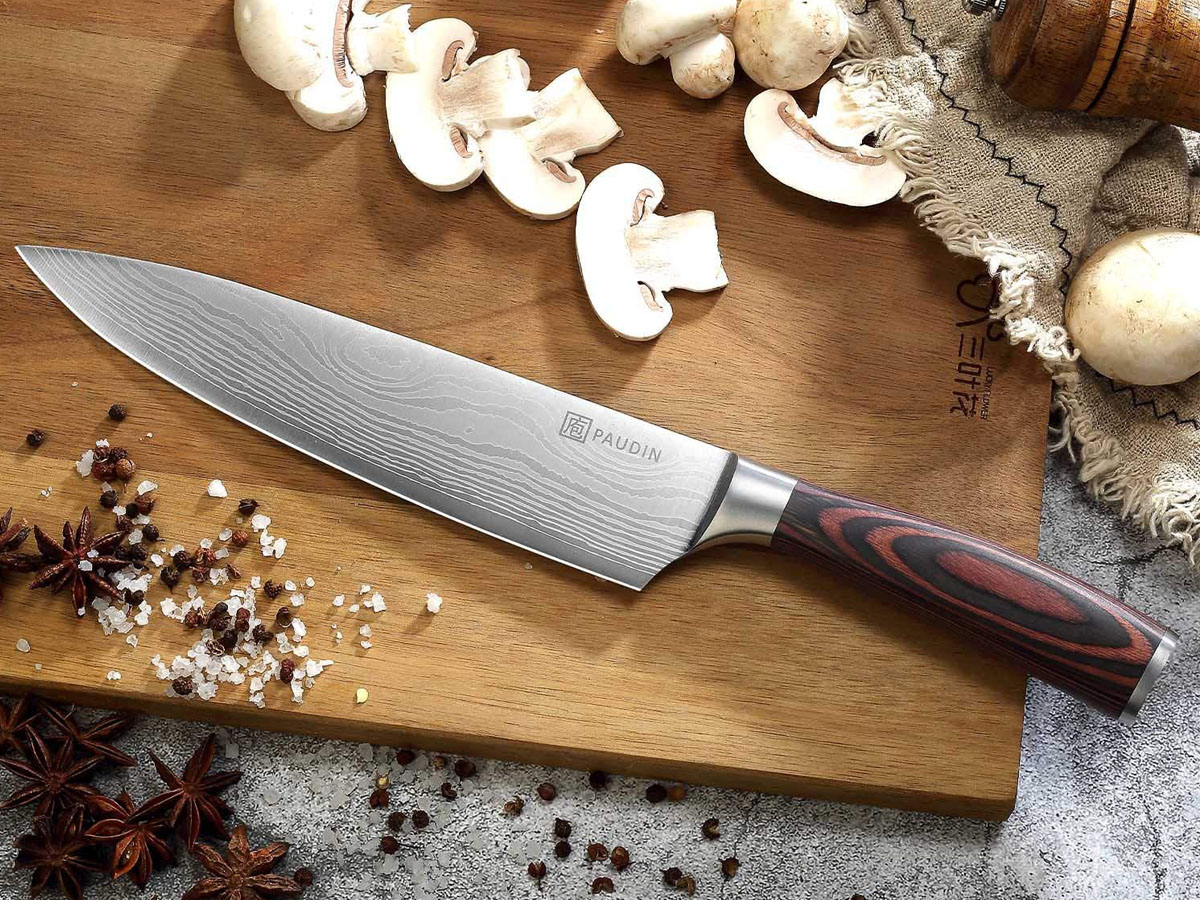
6. Paudin
About the Brand: This newcomer to the knife industry has a mission to produce lovable knives.
Price Range: $$ to $$$
Paudin makes kitchen knives for a variety of purposes. The company makes paring knives, boning knives, chef’s knives, steak knives, cleavers, and more. Paudin prides itself on making knives that are elegant, ergonomic, and economical. It has supplied home cooks and professional chefs with its products in more than five countries including the United States.
Established in 2017, Paudin’s small team has pushed its products to be number one on Amazon, competing with some of the best, most competitive brands on the market. However, this new kid on the chopping block is not backing down, staying true to its principles of exceptional sharpness, durability, and great design.
Top Products:
- Paudin N1 8-inch Kitchen Knife: A professional knife that is easy to hold, the 8-inch high-carbon stainless steel knife has a beautiful design and can cut bread, vegetables, and meat. Get the Paudin N1 8-inch Kitchen Knife on Amazon for $29.99
- Paudin Nakiri Knife Meat Cleaver: This 7-inch all-purpose nakiri knife can slice, dice, chop, and mince. It’s made of German stainless steel with a pakkawood handle. Get the Paudin Nakiri Knife Meat Cleaver on Amazon for $33.99
Shop for more Paudin kitchen knives at:
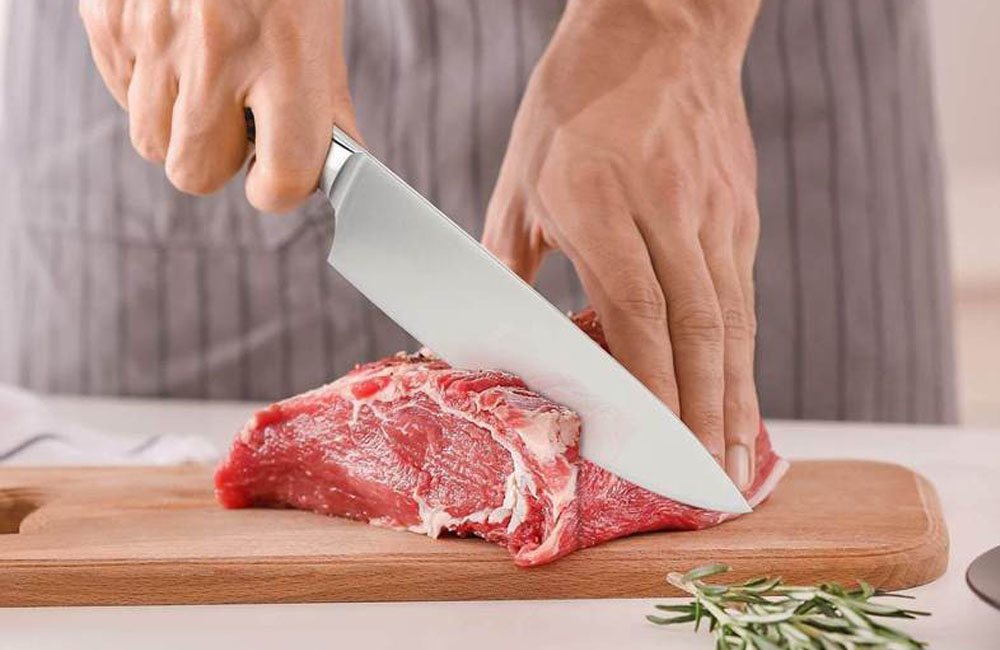
7. Imarku
About the Brand: This Japanese knife brand is named after the owner’s girlfriend and emphasizes craftsmanship, aesthetics, and detail.
Price Range: $$ to $$$
Imarku is a relatively new member of the worldwide knife family, but it is a strong competitor. Having been in business for 13 years, it has quickly made a name for itself in the culinary world. The company specializes in chef’s knives, steak knives, and knife sets. Mark Liu, the owner of Imarku, set out with a mission of democratizing a cost-effective chef knife that is just as high quality as contenders on the market. He stands by his belief that everyone deserves a better cooking tool.
The key qualities that Imarku incorporates in its brand are “craftsmanship, aesthetics, and detail.” It offers a wide variety of chef knives, steak knives, and knife sets with superior ergonomic design. Imarku also offers other kitchen tools such as cookware and cutting boards.
Top Product:
- Imarku 8″ Chef’s Knife: The Imarku Chef’s Knife is an essential knife for any home cook or professional cook who is serious about cutting foods quickly and comfortably. Get the Imarku 8″ Chef’s Knife at Imarku for $39.99
Shop for more Imarku kitchen knives at:
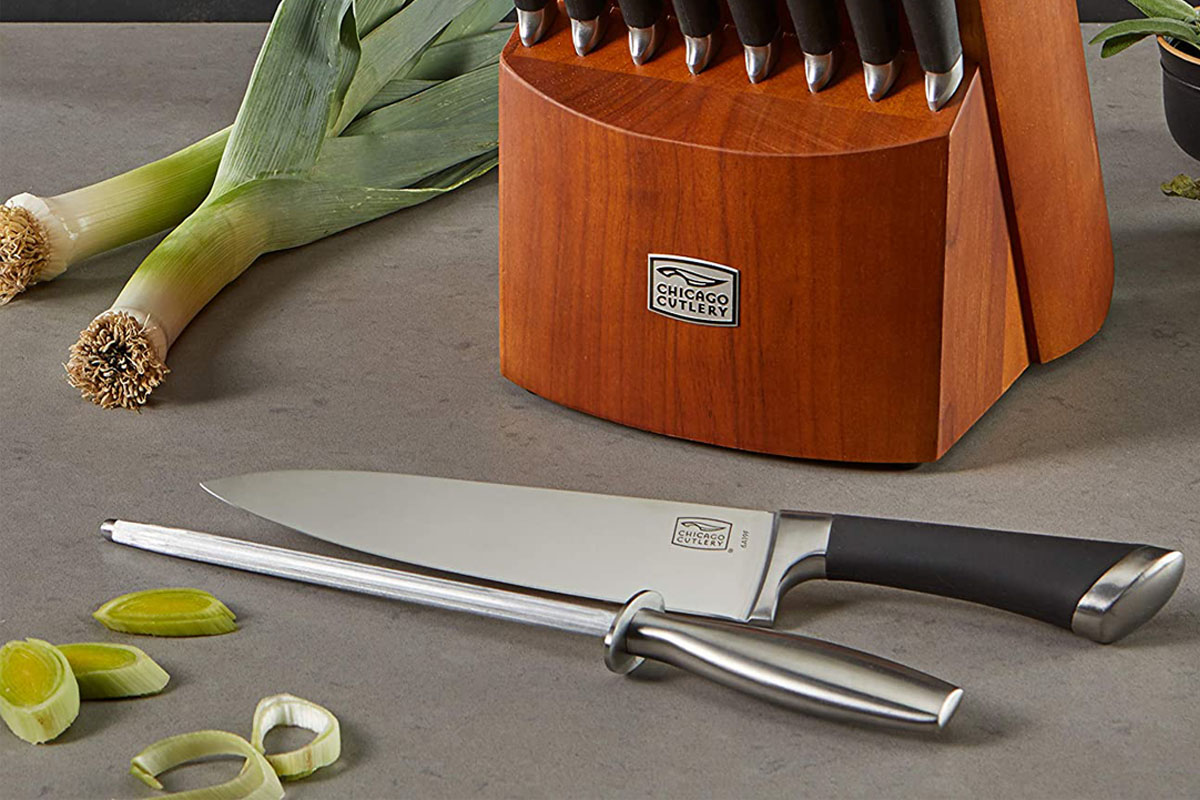
8. Chicago Cutlery
About the Brand: This member of the Corelle brands family is dedicated to bringing innovative products to food-loving people everywhere.
Price Range: $ to $$$
Chicago Cutlery is the cutlery line of Corelle products, which include Pyrex, Corningware, Visions, Snapware, OLFA, and Instant Pot. Based in Rosemont, Illinois, this kitchenware supplier has been operating under one umbrella since 1991. However, it has existed since 1915 when Corning introduced its line of heat-resistant glass bakeware. The company is steeped in a tradition of innovation and strives to bring some of the most groundbreaking kitchen products to consumers.
Chicago Cutlery has a diverse lineup of kitchen knives and utensils. Its knife sets are ideal for just about any kitchen task and have the perfect grip to make slicing, chopping, and cutting almost effortless. As is the case with all of Corelle’s products, this line is devoted to making better products and “improving experiences of food-loving people everywhere.”
Top Products:
- Chicago Cutlery Fusion 17-Piece Knife Block Set: This set of knives includes a paring knife, a utility knife, a bread knife, steak knives, and more, and all are designed to remain sharp and steady while in use. Get the Chicago Cutlery Fusion 17-Piece Knife Block Set on Amazon for $305.40
- Chicago Cutlery Walnut High-Carbon Blade Boning Knife: This 5-inch paring knife has a 25-degree taper grind edge, high-carbon stainless steel blade, and a full metal tang. Get the Chicago Cutlery Walnut High-Carbon Blade Boning Knife on Amazon for $27.20
Shop for more Chicago Cutlery kitchen knives at:
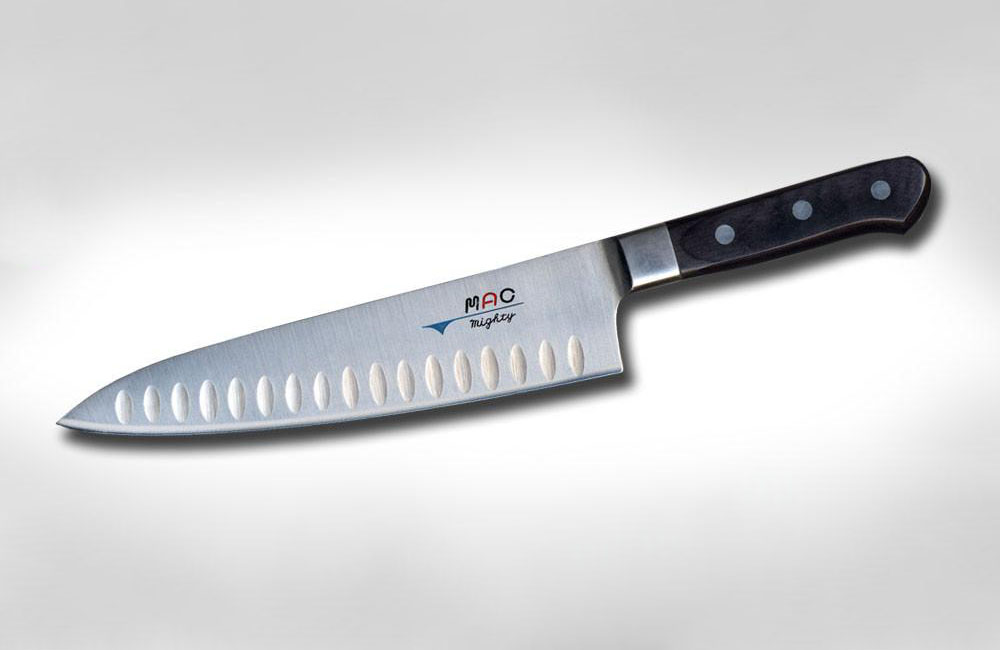
9. Mac Knife
About the Brand: A Japanese knife company that promotes itself as the producer of the “world’s sharpest knives,” it has been selling knives to home cooks and pro chefs since 1964.
Price Range: $$ to $$$
Mac Knife has brought top-notch quality and craftsmanship to consumers worldwide straight from the knife makers in Seki City, Japan. These master craftsmen have been well known for their sword-making skills since antiquity. Today, they have shifted their craft to include making the quintessential knife for home cooks and chefs. Since 1964, Mac Knife has sold over 25 million knives to professional cooks and cooking enthusiasts worldwide. The company claims that customers love their knives so much they wouldn’t dream of going back to their old knife brands.
Since 1964, Mac Knife has sold more than 25 million knives to professional cooks and cooking enthusiasts worldwide. The company claims that customers love its knives so much they wouldn’t dream of going back to their old knife brands.
These Japanese knives are perfect for many kitchen tasks including cutting sticky items like potatoes, apples, and squash. Overall, the durability of these knives lives up to the claims.
Top Product:
- Mac Knife Professional Series 8″ Chef’s Knife with Dimples: A very sharp Japanese knife that glides through food, especially sticky foods, this 8-inch knife is the brand’s most popular everyday knife. Get the Mac Knife Professional Series 8″ Chef’s Knife with Dimples at Mac Knife for $175
Shop for more Mac Knife kitchen knives at:
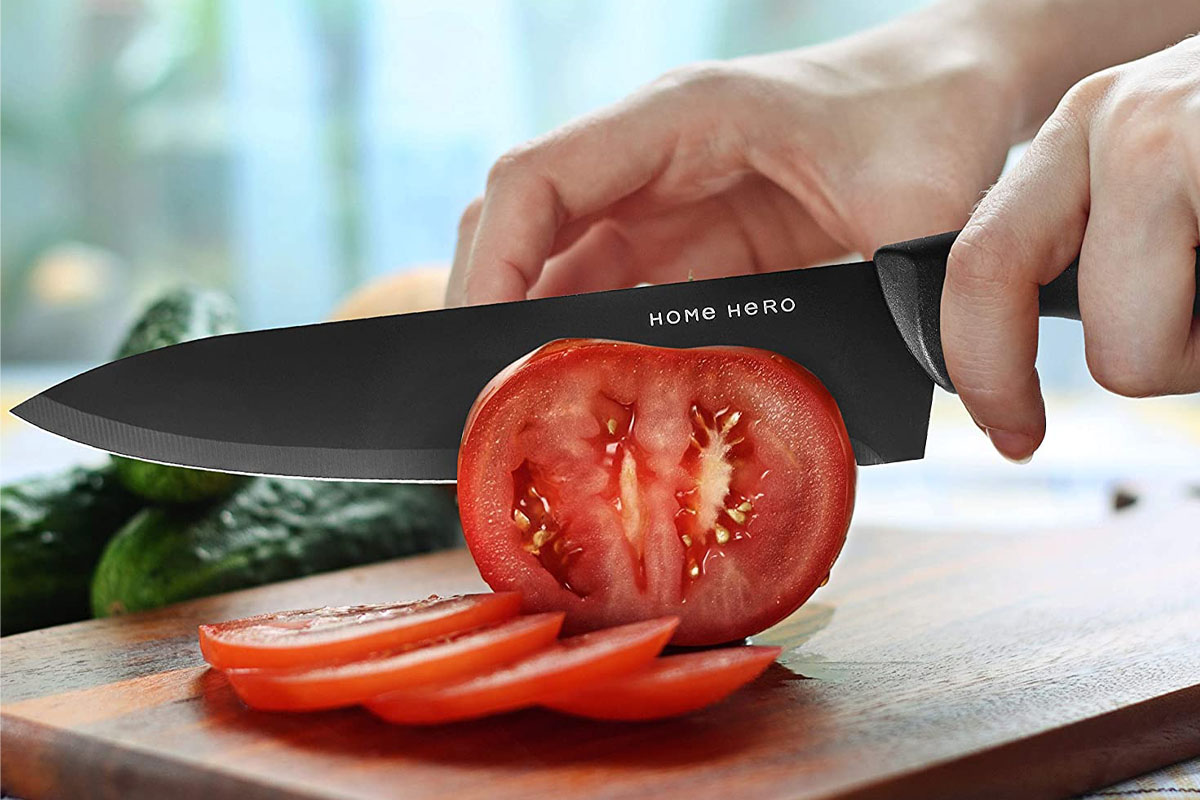
10. Home Hero
About the Brand: This company makes knives for people who are serious about cooking.
Price Range: $ to $$
This may be an inexpensive knife, but it delivers the same high quality as other knives on the market. Home Hero makes cutlery, kitchen cooking sets, kitchen tools, and storage items. The company creates high-quality, innovative, elegant kitchen products and accessories. Its knives are coated with Teflon and are rust-resistant, and the knives’ nonstick coating keeps foods from sticking to them.
Home Hero offers its customers high-end, stainless steel knives that are ergonomic and reasonably priced. Its knives and other kitchen products boast high quality without the high price.
Top Products:
- Home Hero Kitchen Chef Knife: This stainless steel knife has a protective finger guard that makes it easy to handle and easy to cut most everything in the kitchen. Get the Home Hero Kitchen Chef Knife at Home Hero for $8.99
- Home Hero Kitchen Knife Set: A stunning display with an acrylic stand and an all-black 17-piece knife set, these stainless steel knives are also a complete cutlery set for the home cook. Get the Home Hero Kitchen Knife Set at Amazon for $34.99
Shop for more Home Hero kitchen knives at:
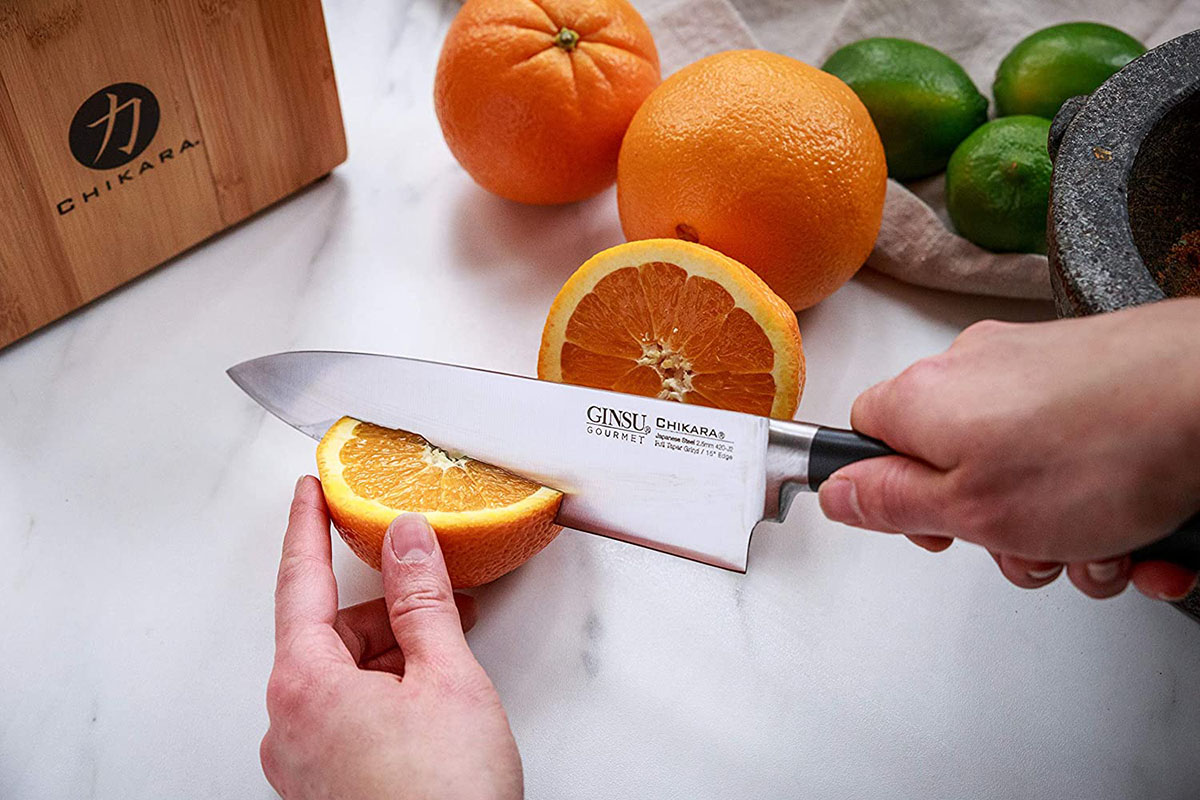
11. Ginsu
About the Brand: The knives that got their start in the infomercial world, the Ginsu brand has been producing knives for almost 40 years.
Price Range: $$ to $$$
Ginsu knives are manufactured by Scott Fetzer Company, a Berkshire Hathaway Company. It became a top-rated kitchen knife brand primarily between 1978 and 1984 due to its strong push to sell knives through infomercials. One of its popular commercials showed a chef cutting through a tin can as easily as cutting through a tomato with the knife remaining sharp. These infomercials helped sell nearly three million sets of Ginsu knives during this time frame. Initially located in Freemont, Ohio, this brand now operates from Walnut Ridge, Arkansas. For nearly 40 years, it has delivered knives with blades that are sure to last. It is a well-recognized brand that is still a hit with culinary professionals and food enthusiasts worldwide.
Ginsu makes a variety of knives designed to cut just about anything in the kitchen. Its selections include utility knives, chef’s knives, Santoku knives, paring knives, and more. In addition, its knives are razor sharp and relatively low maintenance. With Ginsu knives, you can prepare simple meals or complex ones with the confidence that they will perform as they should. Today, these knives remain one of the most well-known cutlery brands. However, the main drawback with the newer model knives is that they seem to have a lower quality than previous models that made the brand famous, so keep an eye out for premature rusting and discoloring.
Top Products:
- Ginsu Gourmet Chikara Series Forged 8-Piece Japanese Steel Knife Set: This cutlery set includes stainless steel Japanese-style knives that give users the confidence needed in the kitchen for chopping, dicing, and slicing. Get the Ginsu Gourmet Chikara Series Forged 8-Piece Japanese Steel Knife Set on Amazon for $99.99
- Ginsu Daku Series: A five-piece set of black ceramic-coated knives, these knives have composite handles and can be cleaned in the dishwasher. Get the Ginsu Daku Series on Amazon for $24.99
Shop for more Ginsu kitchen knives at:
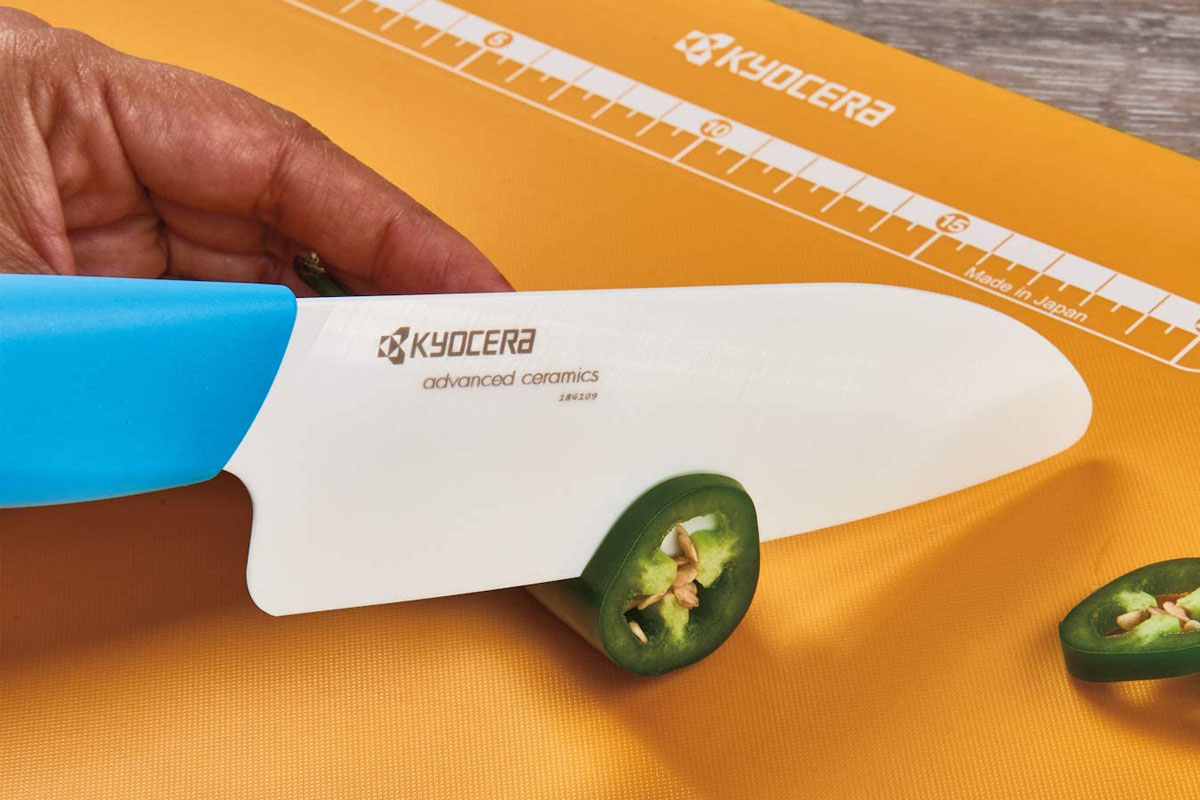
12. Kyocera
About the Brand: This Japanese manufacturer operates in a variety of industries, including cutlery.
Price Range: $$ to $$$
Kyocera is a familiar name because it manufactures many products such as telecommunications, medical equipment, office document–imaging equipment, solar power– generating systems, and cutting tools. Based in Japan, this company began in 1959 under its founder Kazuo Inamori. It specializes in providing ceramic products, one of which is its ceramic knives. Kyocera specializes in ceramic products because ceramic is 50 percent harder than stainless steel and has almost the same hardness as diamonds on the Mohs Hardness Scale. Its ceramic knives are unrelentingly sharp, retaining their superior cutting capacity for much longer than traditional kitchen knives.
The ceramic knives made by Kyocera are lightweight and are supposed to last much longer than steel blades. Made in Japan, these knives are made with a Kyocera-proprietary zirconia material. As a result, the razor-sharp blade won’t bruise or discolor foods it slices, and it is rustproof. Because these knives don’t transfer the metal to your foods, using them to cut and slice your food keeps the food’s flavor pure and free of the metallic taste that most steel knives leave behind. Kyocera knives have many advantages, but watch out for chipping when cutting especially hard items.
Top Products:
- Kyocera Advanced Ceramic Revolution Series 5 1/2-inch Santoku Knife: This sharp knife is perfect for professional cooks and beginners who need to slice, dice, and mince fruits, vegetables, and boneless meats. Get the Kyocera Advanced Ceramic Revolution Series 5 1/2-inch Santoku Knife on Amazon for $44.66
- Kyocera Universal Block Set: The five-piece ceramic-bladed knife set includes a santoku knife, a utility knife, a paring knife, and chef’s knife with a soft-touch universal slotted knife block. Get the Kyocera Universal Block Set on Amazon for $159.95
Shop for more Kyocera kitchen knives at:
How We Chose the Best Knife Brands
While there are many different types of knives used in a kitchen, and there is a range of skill levels among users, creating this list of the best knife brands involved extensive research and consideration of each brand’s intended use. In order to be included as a best knife brand, the company needed to offer well-recognized quality kitchen knife options that are available from popular retailers.
In evaluating the top products from each brand to showcase the best kitchen knives and best chef’s knives, we took care to include knife sets, specialty knives, and multipurpose knives to suit the needs of a range of users. Also, we included brands that offer full tang and those that offer stamped knives in order to meet the budget needs of both home cooks and professional chefs.

